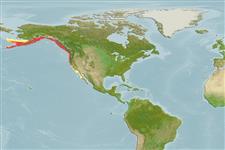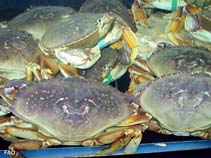Metacarcinus magister (Dana, 1852)
Dungeness crab| Native range | All suitable habitat | Point map | Year 2050 |

|
| This map was computer-generated and has not yet been reviewed. |
| Metacarcinus magister AquaMaps Data sources: GBIF OBIS |
Classification / Names Common names | Synonyms | CoL | ITIS | WoRMS
Malacostraca | Decapoda | Cancridae
Environment: milieu / climate zone / depth range / distribution range Ecology
Benthic; brackish; depth range 0 - 360 m (Ref. 865). Temperate; 3°C - 19°C (Ref. 104779), preferred 9°C (Ref. 107945); 61°N - 23°N, 179°W - 110°W
Distribution Countries | FAO areas | Ecosystems | Occurrences | Introductions
Eastern Pacific: Aleutian Islands, Alaska to Magdalena Bay, Mexico. Subtropical to boreal.
Length at first maturity / Size / Weight / Age
Maturity: Lm ?, range 10 - ? cm Max length : 22.5 cm CW male/unsexed; (Ref. 865); 16 cm CW (female); max. reported age: 10 years (Ref. 104779)
Life cycle and mating behavior Maturity | Reproduction | Spawning | Eggs | Fecundity | Larvae
Main reference
References | Coordinator | Collaborators
Shirley, S.M., T.C. Shirley and S.D. Rice 1987 Latitudinal variation in the Dungeness crab, Cancer magister: zoeal morphology explained by incubation temperature. Mar. Biol. 95(3):371-376. (Ref. 8391)
IUCN Red List Status
(Ref. 130435: Version 2025-1)
CITES status (Ref. 108899)
CMS (Ref. 116361)
Threat to humans
Human uses
Fisheries: commercial
FAO - Fisheries: landings, species profile | FishSource | Sea Around Us
Tools
More information
Max. ages / sizes
Length-weight rel.
Length-length rel.
Length-frequencies
Mass conversion
Abundance
Internet sources
BHL | BOLD Systems | CISTI | DiscoverLife | FAO(Fisheries: species profile; publication : search) | Fishipedia | GenBank (genome, nucleotide) | GloBI | Gomexsi | Google Books | Google Scholar | Google | PubMed | Tree of Life | Wikipedia (Go, Search) | Zoological Record



